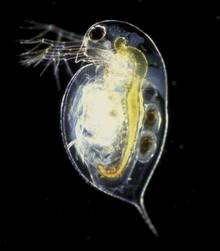Water flea
| Cladocera | |
|---|---|
 |
|
| Daphnia pulex | |
| Scientific classification | |
| Kingdom: | Animalia |
| Phylum: | Arthropoda |
| Subphylum: | Crustacea |
| Class: | Branchiopoda |
| Subclass: | Phyllopoda |
| Order: |
Cladocera Latreille, 1829 |
| Suborders | |
The Cladocera are an order of small crustaceans commonly called water fleas. Around 620 species have been recognised so far, with many more undescribed. They are ubiquitous in inland aquatic habitats, but rare in the oceans. Most are 0.2–6.0 mm (0.01–0.24 in) long, with a down-turned head with a single median compound eye, and a carapace covering the apparently unsegmented thorax and abdomen. Most species show cyclical parthenogenesis, where asexual reproduction is occasionally supplemented by sexual reproduction, which produces resting eggs that allow the species to survive harsh conditions and disperse to distant habitats.
They are mostly 0.2–6.0 mm (0.01–0.24 in) long, with the exception of Leptodora, which can be up to 18 mm (0.71 in) long. The body is not obviously segmented and bears a folded carapace which covers the thorax and abdomen.
The head is angled downwards, and may be separated from the rest of the body by a "cervical sinus" or notch. It bears a single black compound eye, located on the animal's midline, in all but two genera, and often, a single ocellus is present. The head also bears two pairs of antennae – the first antennae are small, unsegmented appendages, while the second antennae are large, segmented, and branched, with powerful muscles. The first antennae bear olfactory setae, while the second are used for swimming by most species. The pattern of setae on the second antennae is useful for identification. The part of the head which projects in front of the first antennae is known as the rostrum or "beak".
The mouthparts are small, and consist of an unpaired labrum, a pair of mandibles, a pair of maxillae, and an unpaired labium. They are used to eat "organic detritus of all kinds" and bacteria.
...
Wikipedia
